Possibly confusing to folks in the US financial media that in recent months had hyped some new QE by the BOJ.
By Wolf Richter for WOLF STREET.
The total assets on the Bank of Japan’s balance sheet as of June 30 fell by ¥3.8 trillion from May, the second month in a row of declines after having already dropped by ¥2.2 trillion in May from April. At ¥732.7 trillion, total assets are now at the lowest level since February 2022. In dollar terms, total assets dropped by $44 billion over the past two months.
This might come as a surprise to the good folks in the US financial media and in the blogosphere who, without ever looking at the BOJ’s balance sheet, had been yelling for months about the huge amounts of QE the BOJ was doing to keep the 10-year yield below its yield peg of 0.25%.
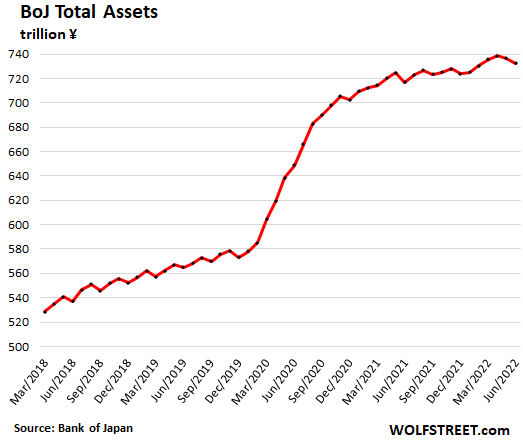
The three major categories of assets on the BOJ’s balance sheet, which comprise between them 99.7% of the BOJ’s total assets, are:
- Japanese government securities: ¥542.5 trillion ($3.98 trillion).
- Loans: ¥139.3 trillion ($1.02 trillion)
- Corporate debt and equity securities: ¥49.1 trillion ($360 billion). They are stock ETFs (¥36.8 trillion, $270 billion), Japanese real estate investment trusts (J-REITs), corporate paper, and corporate bonds.
For a sense of proportion, these are the three categories: government securities (purple), loans (green), and the combined total of stock ETFs, J-REITs, corporate paper, and corporate bonds (red line at the bottom).
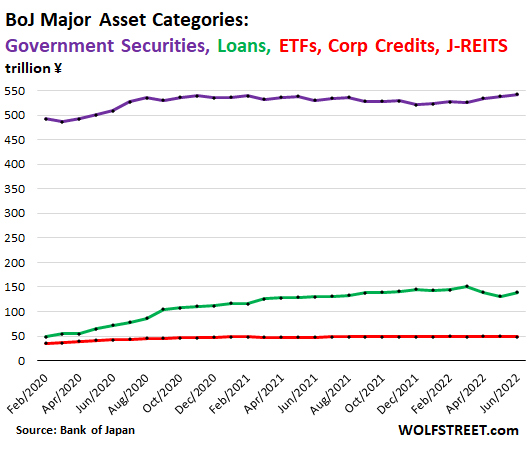
The BOJ’s “shock-and-awe” QE kicked off under Abenomics in 2013. In 2016, the BOJ instituted “yield curve control,” threatening to trade unlimited amounts of Japanese Government Bonds (JGB) to keep the 10-year yield at “around zero percent.” Markets assumed this meant a range from -0.10% to +0.10%. The upper limit has now moved to +0.25%.
In late 2020, after Prime Minister Abe departed, Abenomics was declared dead, and the BOJ began to taper its bond purchases.
A close look at the three QE asset categories.
Government securities holdings on the BOJ’s balance sheet normally rise two months in a row and then decline during the third month as a function of big long-term bond issues maturing and coming off the balance sheet in one month and being replaced in the following month.
Overall, the level government securities had been zig-zagging lower from the prior peak in February 2021. So this was the BOJ’s stealth Quantitative Tightening (QT), which had come despite a flow of announcements by the BOJ that it would continue easing.
In March this year, they fell, and in April and May, they rose on schedule but by a larger amount than in the prior periods. And in June, instead of declining, they rose and ended the month 0.5% higher than in February 2021. In other words, all this ballyhooed yield-curve control action did was undo the stealth QT since February 2021.
At the same time, the BOJ whittled down some other assets, and total assets fell.
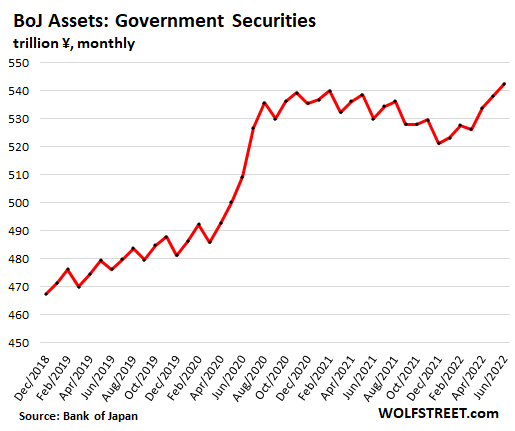
Loan programs on the BOJ’s balance sheet are supposed to stimulate bank lending. Rather than creating money and buying securities from the banks, the BOJ creates money and lends this money directly to the banks – free money. Combined, these loans are the second largest asset on the BOJ’s balance sheet, after government securities, and account for 19% of its total assets.
These loans have continued to soar consistently through March, tripling from the onset of the pandemic through the peak in March.That’s how the BOJ conducted a big part of its pandemic QE. But in April and May suddenly the balance declined, when the BOJ ramped up its government bond purchases. They ticked up in June, to ¥139 trillion, which is down by ¥12 trillion from the peak in March, and back where they were in October 2021:
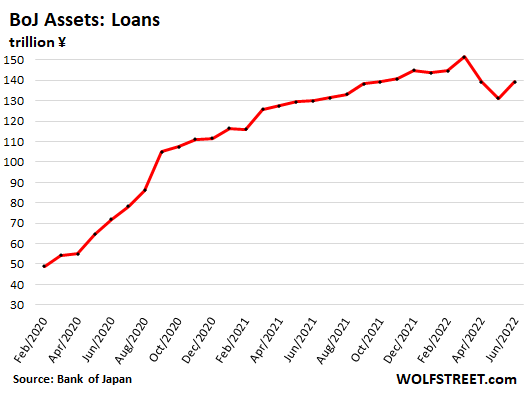
Stock ETFs, corporate bonds, commercial paper, and J-REITs account for just 6.7% of the BOJ’s total assets, though a lot of hype was centered around them in the US financial media. The BOJ adjusts the ETFs to market value, and they fluctuate with the stock market, but overall, they haven’t gone anywhere since February 2021:
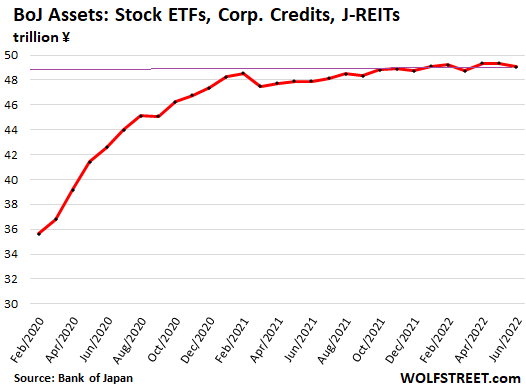
Total assets, long term: How the BOJ went nuts.
You can see the dip in total assets over the past two months on this chart of QE going back to 2001.
The BOJ instituted QT for 18 months, from January 2006 through June 2007 (circled in green), during which it reduced its assets by 36%, unwinding five years of QE, and total assets didn’t return to the 2005-peak until 8 years later as Abenomics kicked off:
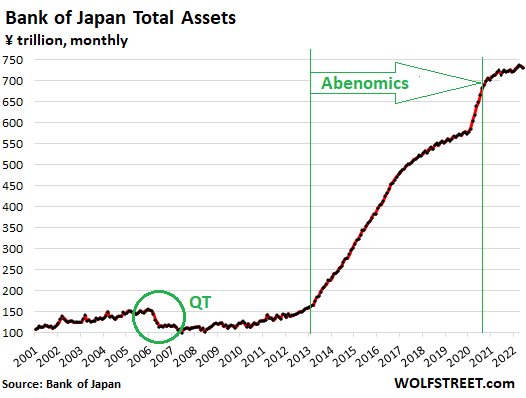
Enjoy reading WOLF STREET and want to support it? You can donate. I appreciate it immensely. Click on the mug to find out how:
![]()


Paging Mrs. Watanabe, please pick up the white courtesy phone and make some trades.
So many financial regime (but even more, narrative) changes are underway. I’m no expert, I just see lots of dominoes trembling around each other (between different narratives). I’m ready to deploy a little bit of cash into some side bets back into USA markets, that just might pop.
Off topic, new USA laws, I hear, on Chinese/Xinjiang supply chains, snare lots of companies ill-equipped to do compliance, so there is a redeployment expected to other regional sources, such as factories in Vietnam. Overall magnitude, or effects on Japan, I don’t know. This is just a sample of weird cross-winds through this whole picture.
That Chinese doing mass testing story in Shanghai seems like particularly bad news. Zero Covid and refusal to switch to mRNAs. Why autocracies tend to fail over the long run, I suppose, it’s tough to get rid of bad management.
Wolf, could you help clarifying the tweet from Michael Burry about the fact that the Fed didn’t roll off any mbs from their balance sheet in June? When I looked at the balance sheet it did look like in fact they added 2 billion over the month instead of rolling off 17.5 billion. Is it because the mortgage purchases/refinances are drying up and they accidentally bought too many?
Dan,
Burry is ignorant or lying – take your pick. Don’t post his BS here. And you’re don’t know nada either, it seems. So quit posting this tightening-denier BS here.
1. Since the April peak, the Fed’s balance sheet has declined by $52 billion!!! That’s QT.
2. The Treasury roll-offs occur twice a month, mid-month and end of month. In June, they occurred on June 15 and June 30. The last balance sheet was through June 29. And so the June 30 roll-off wasn’t on it. Get it?
3. I’ve said this a million times already. But you chose to not know.
4. The June 30 roll-off will be on the balance sheet to be released tomorrow, and I will make sure to cover it and I will ridicule that idiot Burry and all the other tightening-denier idiots. You chose your camp.
I’m just really tired of this tightening-denier braindead ignorant BS that people vomit into the comments here. Every day, people post this same BS here without ever reading anything, just regurgitate the same BS they saw somewhere else. And I have to waste my time shooting it down over and over again.
39 years of Fed Politburo reducing the price of money, conjuring/depreciating purchasing power, putting said currency into the hands of churners and skimmers, instead of value creators.
No wonder there is an entire generation expecting the Fed Calvary to ride to the rescue of the mess they have wrought.
In fact, without the Central Bankers, the destruction of the Social Contract would never have been possible.
cavalry
I always suspect guys like Burry are trying to drive markets up or down to support their bets.
That’s called talking up there book
The balance sheet has grown since May 25th. So if they are reducing it , they are doing so in an uneven fashion.
https://www.federalreserve.gov/monetarypolicy/bst_recenttrends.htm
Paul,
That’s a lie. Look at the numbers. The last balance sheet was down from May 25.
MBS go up and down every week, for reasons I spelled out here many times, and so they will go up one week and then go down another. They ALWAYS do that. So if some idiot says that there is no QT because MBS went up by $2 billion in one week, when the following week they went down by $17 billion, well, then, that’s just an idiot.
I looked at those graphs, and a thought occurred to me. How about trying it on a logarithmic scale, or if not, think of it in those terms? The BoJ’s QT from ’06-’08 cut their assets by 50%, just from eyeballing the chart you posted. Do that again, and wouldn’t they end up at about 350 trillion yen?
It seems a tad bit hopeful to call what BoJ has been doing QT. Maybe it turns into that, but can we agree that they have a long ways to go?
Wolf would normally add that the Fed’s MBS portfolio transactions take a few months to settle, so that data shows up with a lag. So the June MBS roll-offs will hit the tape in September or whatever.
This is not to say that the Fed doesn’t lie – but this isn’t where it happens. They do it more subtly via the narrative (like, “inflation is transitory”, or “subprime is contained”).
In the financial markets, it seems to me, the only thing that isn’t potentially wrong are the most recent trade price quotes. And even trades can be spoofed to generate fake momentum and trigger speculative interest to unload onto greater fools. Archegos tried and failed at that.
I just didn’t split it out. MBS are down by $31 billion from April high.
The exchange (FX) value of the yen is falling faster than a lead balloon thrown over the ledge of the Grand Canyon, and now would be a great time for Japan to consider a 1000 to 1 reverse split of their ‘currency.’ It is beyond me to comprehend why there was ever any ‘carry trade’ going on its worthless currency. The country of Japan has been insolvent since 1989 and they should have just said that back then.
“…insolvent since 1989…” Hahahaha, sure is a long time to be “insolvent” while pretending you are not.
Actually, a country that issues its own currency, like Japan or the US, cannot become “insolvent” because they can print their way out of insolvency.
But they can and do destroy their own currencies through inflation. That’s the real danger.
But Japan has had a lot less inflation than the US over the period you mentioned; over this period, the dollar’s purchasing power in the US has collapsed, while the yen’s purchasing power in Japan has declined far less.
State provides quality ramen?
WOLF
How do you explain Japan’s moderate (compared to US) inflation when Abenomics for 8 years flooded their country with fiat at a greater comparative pace vs the US ??
Beardawg,
The fact that QE in Japan since 2000 – at first slowly then massively – hasn’t created large-scale inflation in Japan has been used by the Fed and the ECB and others, and by economists in general, to say that this time it’s different, this time, money printing will not cause inflation. And for years, they were right.
But now they’re suddenly proven wrong. The whole theory is proven wrong. Now there is raging inflation.
And there is suddenly a lot of inflation in Japan, and it’s a big issue in Japan, and people hate it, and BOJ head Kuroda has come under withering fire for making tone-deaf comments about the benefits of inflation, after core CPI rose to 2.1%, above the BOJ’s target.
Wholesale inflation in Japan has been over 9% for 5 months. The government is subsidizing certain wholesalers so that they would not pass on the price increases, which helped hold down retail inflation. In addition, the entire healthcare system is under the government (insurance and what healthcare providers can charge patients), and the government has pushed some rates down, with further helped lower CPI.
Here is more:
https://wolfstreet.com/2022/05/20/inflation-comes-to-japan-amid-plunging-yen-and-inflation-subsidies-bank-of-japan-blows-it-off-as-transitory-throws-yen-under-bus/
Consumers are still very resistant to inflation in Japan, and they’re going on buyers’ strike if a retailers tries to raise prices — unlike in the US where people just pay whatever — and this has helped keep inflation low, and that’s what Kuroda was bitching about. But now that resistance is fading because people are running out of options. And they’re starting to have to pay those higher prices.
I’m wondering if the lesson might be that QE takes longer to show up as inflation in the real economy compared to just printing more currency, since it’s more indirect and often bailing out speculators’ losses. Maybe where it shows up first is asset inflation since money printing goes to the top and some of it trickles down. But eventually it shows up.
I don’t think the central banks have a great understanding on the relation between QE and inflation, or at least I don’t. Also, I believe you need at least some inflation at times just to keep deflation at bay, but probably stimulus checks are a better way to go since you see it hit the system faster and the bottom 90% tends to spend more of their windfall. More bang for the proverbial buck.
Nate, inflation used to be defined as the expansion of the amount of money. Consumer price index is only a possible indicator that inflation is going on. CPI is not the inflation.
Asset price may be be considered a price index that indicate inflation as is stock market indexes.
Only cavecat, these indexes only indicate (monetary)inflation on the way up. Falling prices do not nessesarilly indicate monetary deflation.
They didn’t piss off china ,which controls low priced semiconductors,and almost all manufacturing. But s. Korea seems to be ok STRANGE,maybe silent partners
According to Macrotrends website, the Yen has appreciated slightly versus USD since 1989 closing at 143. Look up the exchange rate yourself.
Wolf,
1st paragraph. Yen symbols are displaying as Euros. Hidden message? ;)
DXY : July 4 a setup bar. July 5 a trigger. In order to move higher there
must be a close > the trigger high @107.26.
Watch out.
Wolf gives BOJ assets as €732.7 trillion, in his opening paragraph. That is a lot of Euros. They should remain solvent for a long time.
In other news, I see Zimbabwe is ditching the US$ and will issue gold coins. I wonder how long that will last.
Things are getting interesting.
Yes, that’s a lot of euros. The ECB should learn a lesson here :-]
Thanks!!!
How long will it last? Until the people discover the coins are made of steel core and fake gold leaf.
Coins are made from aluminum in Japan.
Yes, just the one yen coin and it has been for years.
And the USA has now a penny only plated with copper.
In what can be described a short time frame, commodities have dropped a lot. Stock market has dropped a lot. Crytpos have dropped a lot.
Fed has actually done a pretty good job in knocking down future inflation in what can be described as a very short time.
Commodities are the input for future prices.
The FED cannot fix supply chain inflation but they they have squashed the commodity inflation.
I don’t think the Fed has done that with their actions yet…
However, one tool the Fed uses is
“jawboning”, which as the Wolfster has pointed out can be effective and may be a factor in your summation…
Ppt working overtime,or fed forced banks to short commodities,or profit taking
Nope. There is no such thing as the PPT and commodities are plunging due to MASSIVE DEFLATION which is unstoppable.
SoCalBeachDude,
Are you a bot with zero ability to recognize sarcasm???
You fall over the same thing over and over again. It’s funny really.
Comodities are the input for future price and future supply. I would watch the volumet in tonns or whatever the commodity is measured in.
If volumes of commodities do drop we are heading for a loss of purchasing power price drop. Future supply is then to drop too. That end game can quickly become ugly.
Real estate market is 2 – 3 times bigger than the stock market and much more leveraged. That one has to croak as well.
Much longer holding periods; much more friction; doesn’t mark to market all the time because it’s not a standardized asset.
USD/JPY : June 20 a setup bar, June 21 a trigger. No new higher close above June 21 trigger high.
Watch out.
The end of Iran/Iraq war, new oil fields in Alaska, the Gulf of Mexico,
the N. Sea, Siberia created an oil glut in the 1980’s and the 1990’s.
The oil glut beat inflation, not Paul Volcker.
I’m wondering whether the econ crowd, and particularly the Fed econ crowd, actually understand inflation as well as they think they do.
Supply, demand, and pricing are a lot more complex than the basic intersecting-lines graph from Econ 101.
Genuine supply shortages trigger price increases, and price-momentum generates speculative demand (hoarding) which amplifies the shortage and creates a bubble.
Monetary-policy responses can pop the speculative bubble, but if the original shortage isn’t addressed, slow-burn inflation will continue.
Japan has been the United States butler for a long time, but they have also tried to keep a sort of long term insurance policy for their currency / economy.
The Yen/Gold chart is one of the cleanest gold charts in the world, and last year the BOJ started buying gold again even though they still hold a lot of U.S. treasuries. They have about 5 trillion Yen in gold at current prices.
At some point Japan is going to have to move back to Asia, away from the U.S., and if they start abandoning the dollar and shifting to regional currencies and commodities, it will be a mess for the UK/U.S.
Japan has learned a lot from the U.S. about how to use balance sheet type trickery to play three card monte with the economy.
https://www.reuters.com/article/us-japan-economy-mof/in-rare-move-japan-sells-gold-to-fill-budget-hole-idUSKBN28R0LY
But at the end of the day Japan’s ultra clean gold chart points to them not being as delusional as the economists driving the UK/U.S. into the rocks.
I just read the linked article. The Japanese gov sold the gold to the BOJ and there were some other arrangements. In other words, they didn’t really sell the gold, they just shuffled it around amongst each other, and the BOJ handed the government some cash to spend.
1) The gov insult energy producers. JP hikes might send WTIC
down too far, too fast..
2) WTIC weekly : Feb 28 2022 a setup bar. Mar 7 a trigger. After 17 weeks there is no higher close > the trigger high.
3) JP, u have done a wonderful job fighting.
4) JP, the risk is that WTIC will cont down causing a prolong deflation.
5) The big picture : Mar 7 2022 high is a lower high under 2008 high.
6) After 14 years WTIC was rising in a turtle speed to Mar 7 2022 high.
7) Target #1 : 0.886 retracement of the move from Nov 29 2021 low to
Mar 7 2022 high, to about 70, looking good.
8) Target #2 :
Absolutely bonkers. Will any/all of the world central bankers be able to ween themselves off of the easy money? I agree they are beginning to turn the corner. But will there ever be a return to the pre 2020 debt. Will these programs be retired before the next emergency or crisis? These Japanese charts presented are very shocking
I just saw an article that AT&T is paying a $10k sign-on bonus for installation techs.
If we have a recession, we might not have any layoffs. Companies have so many job openings and current employees are working overtime, a recession will mean they can just get back to normal. LOL
Company I work for increased their referral bonus 4x.
Crazy and we are probably already in a recession? That is what some talking heads are saying.
It would be a very strange recession indeed if unemployment stayed low.
Companies seem to have a shortage of skilled labor technicians and an oversupply of office workers. That is the problem- an HR person at AT&T can’t be retrained to install land lines or service routers and cell phone towers- they are just too dumb to train.
It isn’t that simple. Massive conglomerates can’t just retrain their staff from being a cell phone sales representative do routing internet backbone traffic or from creating content to managing the HR department. These organizations are very large and have silos and layers of management that restrict employees.
Speaking from experience I was GTE / Verizon for many years as a system integration engineer
Companies stopped training employees years ago. Waste of time and money. Other companies would just hire away the newly trained employee.
Everyone can be retrained look at WW 2 Sallie the riveter,more a question of if they will do it . Hard economic times change many things
You are correct small bug!
There were ”mid career” folks in their forties in my Construction Tech ROP (Regional Occupation Program) classes in central CA in mid ’80s.
Just got tired of the corporate rat race or just sitting in front of computer all day even then.
Didn’t seem to have any problems quickly learning basics of building/construction.
With the massive availability of good instructors free on web these days on most subjects, and frequently now focused on specific skills sets,
IMO it is much easier to get useful instruction and advice on carpentry to fine tile work etc., than it used to be; folks just need to understand that it takes some practice to become ”highly skilled” at any or almost any activity, eh?
Years ago I told a Comcast come to your house tech, “Sorry, but I’ve hated Comcast since day one”.
He said. “Me too, I’m just an on call independent contractor”
The wonderful and magnificent US Dollar is now at 107.19 on the DXY and is up another 0.66 today!
There is a limit to dollar strength, before foreigners that borrowed in dollars start blowing up. I would think it is starting to happen at this rate if it lasts.
I suppose the Japanese, being an exporting nation want their currency as cheap as possible. They are doing an excellent job at sending the US dollar higher. Takes the bite out of inflation for the US.
I wonder at what point the Japanese will stop defending their bond peg? Possibly never. Could be we’re heading for 120 on the DXY.
Actually, the US Dollar could go as high as 160 on the DXY where it was last back in 1985!
“… the Japanese, being an exporting nation want their currency as cheap as possible.”
No they don’t. They’re HUGE importers of all kinds of stuff, including energy and raw materials, food, clothing, components, devices, etc. Their big companies rely on China and Thailand and Vietnam just as much as our big companies do. And all that stuff is now getting much more expensive.
And they’ve been running a trade deficit in recent months!
So then why are the Japanese allowing their currency to be devalued? I am quite perplexed at their central bank policy.
Seems they have complete control over the matter. Just drop the bond peg and their currency will appreciate.
Yes, everyone is perplexed about the BOJ policy, but the new prime minister is all for it. Election coming up, so we’ll see how he does. As a politician, it’s hard to give up free money that you can buy votes with.
But when you get raging inflation, then you have to choose. In the US, we’re now choosing. Japan still doesn’t have THAT kind of inflation problem, but it might get there, and then THEY will have to choose too.
Exactly right. This is the real story of oncoming financial destruction that no one is paying attention to.
Yahoo: In-depth US Federal Reserve study finds nothing on horizon to rival dollar’s status..
It is a real shame that ALL of these Central Banks are having to do QE and QT together. I am not sure how we get out of this jam without a global recession at this point.
Interest Rates :
Holding The Fed accountable needs to happen to avoid recurrence
Until accountability becomes a reality only the accountable shall walk the walk and talk the talk while the rest sink.
Sure their are cures like raising short term rates returning normality
but what about all who suffered in so many ways & vast sums lost during this nightmare .
Walk away and turn a blind Eye ? is that a Answer or what’s left .
> Holding The Fed accountable
Like the courts, here is a really weird line to walk between political independence and (the right form of) accountability. Look at Erdogan in Turkey meddling with central banking, far worse than anything we’ve ever seen. Then, imagine any recent US President or the mob at Congress doing the same: TOTAL sh!tshow. Just shortening the term impairs independence, in a way likely to be as ugly of a new balance as the fed’s own moves the last couple years.
Outside of that, what? Our neighbors with torches and pitchforks?
Similar to the pause between 2017 and 2020. That curve will start back upwards at an even steeper rate by 2023 at the latest.
Same applies to the Fed.
There is just no exit from QE now.
QE is long since over and will not be coming back. Get over it.
Not true. Not at all. The exit exists and is as simple and plain as it ever was: embrace short term pain (that won’t even be that bad) for massive long term gain.
Indeed, with inflation here, there is no non-exit from QE. That era is over.
No exit from QE, and no non-exit. That’s the historic dilemma that has been engineered here. I think it shows in the weird flicker now between inflation and recession. It is as if we are living in a world with slices of both in the same moment: overheating and stuttering. I only wish it was a movie and not my life.
Because SOMETHING will happen, and it is possible that the something is just ugly.
If politicians don’t want to be responsible with budgets it’s up to the Fed to provide discipline or keep the party going with a good hard can kick.
Wolf, drawing on your direct experiences with the Japanese people, and your knowledge of business, finance, and money, I wonder if you can help me understand something:
Western news always seems to portray the Japanese economy after the price asset bubble collapse as a smoldering ruin of stagnation. My impression of the story being that out of control deflation ruined them for 10-30 years.
Yet, based anecdotally on what I’ve seen and read about living in Japan, ordinary people seem to have no worse of a life than ours, and surely their levels of income inequality are no worse than ours.
Is this just me not seeing the real impact because I just haven’t seen that side of Japan?
Thanks!
Yeah, suppressed interest rates, a moribund stock market, aging population, for like, decades?
Is THIS at long last the big inflection they have staved off?
Japan is one of the few countries that had something resembling true price stability for about two decades: Inflation followed by a little deflation followed by more inflation. There never was a “deflation spiral” or a “lost decade” or whatever. That’s NY Times BS.
But the low inflation period may be over now.
Concerning what life is like in Japan, you will just have to go there and check it out. You will be amazed for sure.
Fukushima was the lowest point in this 22 years lifeless CPI trading range. Since then inflation is up. Since Fukushima USD/JPY is up.
The German 3M moved up to (-) 0.342 indicating a deposit rate hike.
That might weaken DXY and possibly strengthening JPY.
I would love to visit Japan, but not feasible in the near future for a number of reasons.
My grandparents travelled the entire world (at least everywhere you could legally go) in the 50s and 60s. They loved Japan and I enjoyed the pictures. They always made slides and the whole family would gather to vicariously enjoy their travels on a projector screen. My grandfather would speak about each slide and he remembered every tiny detail.
The Japanese people were very nice to them. I look back with amazement at how he could even want to go so soon after his sons had fought the Japanese, but then again, he was the wisest man I’ve ever known. He believed in the goodness of all of God’s people.
Imagine 8 billion people trying to fly around the world in their retirement. Now you will understand why there won’t be any retirement.
I had a feeling there was something more to the story. Correct me if my interpretation is wrong: You’re saying that their currency has (up until recently) remained at relatively the same value for almost 30 years? Sounds good to me! But I guess it all depends who who you are, what your financial interests are, etc.
As to your second point, YES PLEASE! My family and I are big fans of exported Japanese culture, having gotten started with the Studio Ghibli films. We want to go as a family someday and experience the Japanese people for ourselves.
Things are looking a little brighter for us in the near term, so hopefully we can start saving money for a trip.
Anyway, thanks for helping me understand better. I always like to fit another piece into the puzzle.
BIG LIKE, sir. ;P
Is it fair to say that the BOJ may not be buying government bonds to peg the 10 year at 25bps but is instead letting the exchange rate blow out via capital flight as other countries raise rates? Over the last 5 years or so the yen:dollar exchange rate has been around 114 with little volatility. Since March the exchange rate has ballooned from 114 to 136. Printing money to monitize government debt is inflationary but so is letting the exchange rate blow out. They are basically choosing their poison.
Well… watching closely as our house is in Osaka. Looking to retire in Japan so following Wolf’s words daily.
Shinzo Abe apparently assassinated Friday morning July 8, 2022 at 11:30am while this 67 year old former Japanese Prime Minister was giving a speech on the street in Nara. Abe dropped to the ground after the second shot. No vital signs recorded a short time later. The attacker did not flee.
Apparently these events are rare in Japan.
England, Germany, Japan… our former enemies are now our closest friends.